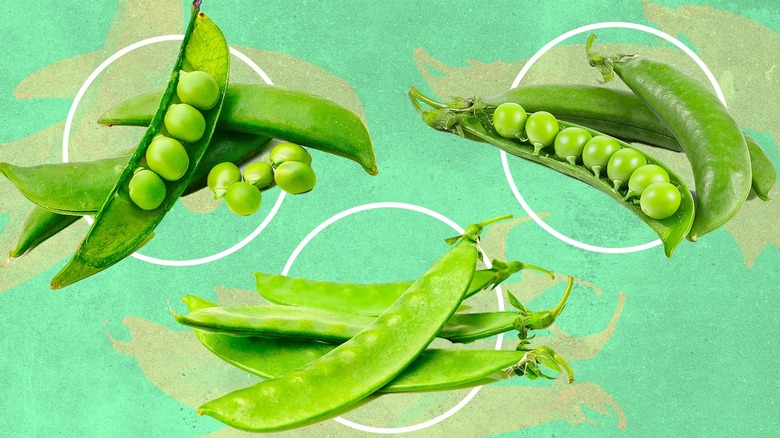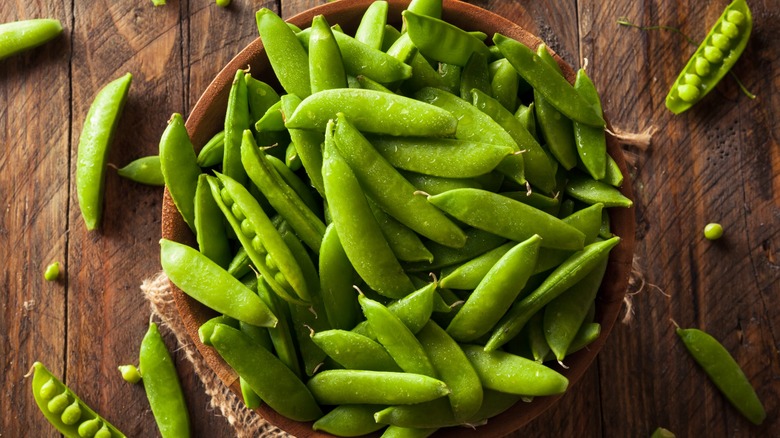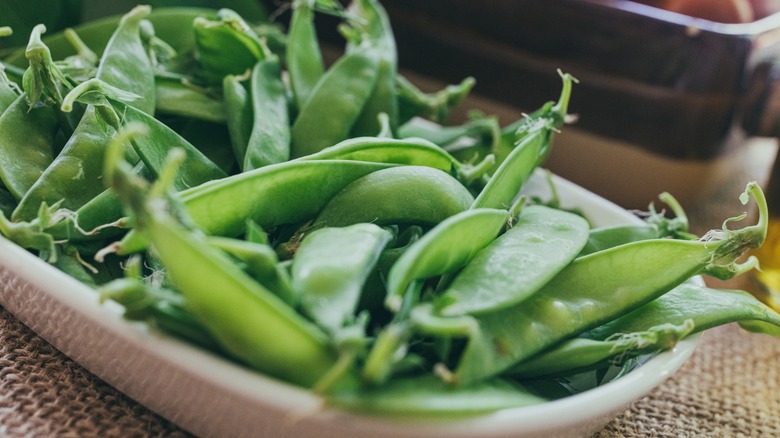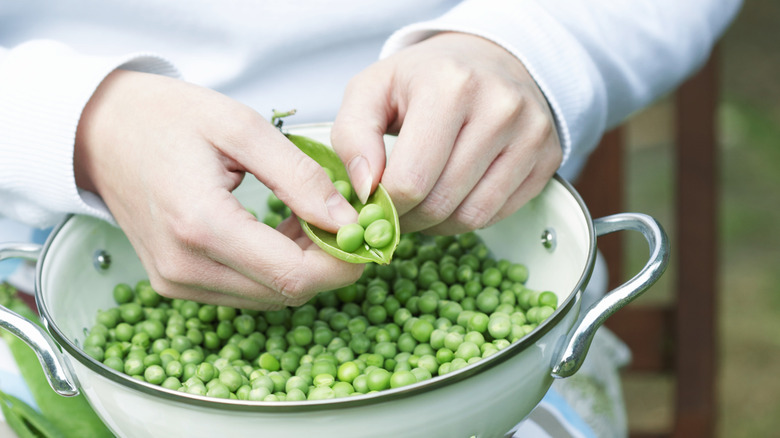The 3 Types Of Peas, Explained
When thinking of peas, the first image that comes to mind is probably tiny, green balls with a lightly sweet flavor to them. And while this image is accurate, there's so much more to peas than meets the eye. There are actually three different pea varieties available at most grocery stores, and each one has a slightly different look, flavor, and best preparation style. For example, you can eat the pods of some pea varieties but not others.
While these differences might not be super dramatic, knowing a little more about the different types of peas will allow you to better enjoy them. The three most common pea varieties are snap peas, snow peas, and shelling peas. Even with their differences, all three types are in season around the same time. Prime pea season is from spring through the earlier months of summer, though many varieties can be found year-round.
Once it starts to get over 80 degrees Fahrenheit, the pea season will come to a close as the plants don't grow as well in the warmer months. If you're looking to experiment and try all the types of peas available the best place to go is your local farmer's market or fresh produce stand. Whether you eat them raw as a snack or toss them into your favorite stir fries, this is your sign to incorporate more peas into your meals this spring.
What are snap peas?
Snap peas are sometimes known as sugar snap peas due to their fresh, sweet flavor and the pleasant crunch they have. You can identify snap peas by their bright green color and by the thicker, juicer peas inside. The outer shell of snap peas is edible, just be careful of the stringy bit that keeps the pea pod sealed. You may want to gently peel this off and string your snap peas before eating them. You can tell a snap pea is good to eat if it's clear of any discolored spots, the skin is firm and smooth, and it has that signature fresh green color.
Snap peas are typically good for up to five days when stored unwashed in the fridge. You could also blanch and freeze them if you wish to expand their shelf life. Frozen snap peas are good for up to a year if stored correctly. You can enjoy snap peas raw, dip them into hummus or ranch, or sauté them with garlic and butter for a perfectly light side dish. You can even chop them up and add them to salsa (Chef Alex Guarnaschelli loves adding snap peas to her salsa verde). Snap peas are a great way to introduce more vegetables to kids, as well — their mild flavor and sweetness make these legumes particularly inoffensive to pickier eaters.
What are snow peas?
Snow peas are similar to snap peas in terms of having an edible pod and a sweet flavor, but the appearance of these two types of peas differs. Snow peas, also called Chinese pea pods, are flat, wide, and slightly translucent. They have a bright green color, but the peas inside are small. The main outer pod is the bulk of the edible part of the snow pea. As with snap peas, you'll want to remove the stringy part that seals the pod together before eating them. Snow peas are edible raw, but if you're eating them cooked, you'll most commonly see them in stir-fries, like this vegetable stir fry.
Snow peas have a slightly chewier texture than other types of peas. They are also harvested before fully ripening so that the peas inside don't become too large. Avoid snow peas that appear wilted or discolored. Like snap peas, snow peas can be stored in the fridge or blanched and frozen and will last around the same amount of time. You can also give your snow peas a more uniform appearance by trimming off the ends of each pea pod. Don't cut off too much, though — just the tips will do.
What are shelling peas?
Shelling peas — also called English or garden peas – differ the most from the two types of peas already mentioned. Unlike snow and snap peas, the outer shell of shelling peas is not edible. Instead, the pod is tough and fibrous. It also has a bitter taste. The "shelling" name refers to the process of opening up the pea pod and collecting the peas inside, after which the shell is discarded.
At some markets, you can buy the peas already shelled, but if you buy the whole pod be sure to put aside time to shell your peas before cooking. The peas within are big and sweet, similar to those found in snap pea pods. Shelling peas are the most common variety used for canned and frozen peas that you might buy at the supermarket. You'll want to use your shelling peas fairly quickly (within three days) after buying them so they don't spoil.
If you want to freeze shelling peas, you should shell them first, blanch the peas, and then freeze them for up to a year. Shelling peas can be deliciously blended into different sauces, mixed into salads like this springy pea salad, or even tossed into creamy pasta dishes. Their fresh flavor and firm texture make them a great addition to a variety of recipes. You can also sauté them in butter and serve them as a simple side.



